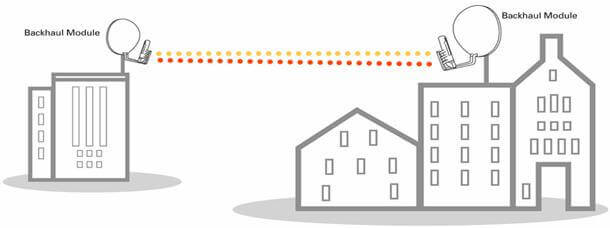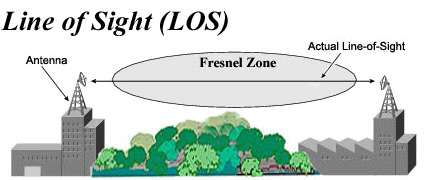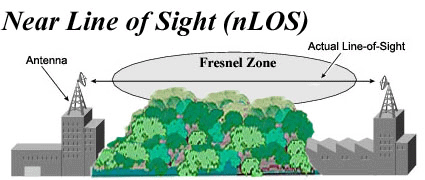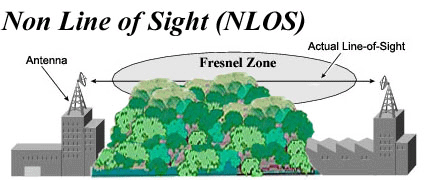Point to Point Wireless Ethernet Bridge:

Outdoor Wi-Fi Range:
The range of a wireless link is dependent upon the maximum allowable path loss. For outdoor links, you will get a strong signal as long as there is clear Line-of-Sight between the two antennas with sufficient clearance for the Fresnel zone. For Line-of-Sight, you should be able to visibly see the remote locations antenna from the main site. (Longer distances may require the use of binoculars). There should be no obstructions between the antennas themselves. This includes trees, buildings, hills, concrete, steel, power lines, or a drastic change in elevation, etc. As the distance extends beyond six miles, the curve of the earth (commonly called earth bulge) affects installation, requiring antennas to be placed at higher elevations. Use the 24dBi grid antennas for distance this far, or contact one of our technical consultants for a free path analysis. Please contact us to discuss purchasing a point to point connection, as there are variables dependent on transmitting a strong, reliable wireless signal.
What is Point-to-Point and Point-to-Multipoint Bridging?
What is Point-to-Point? When connecting two points together (Also referred to as a Wireless Bridge kit), the distance, obstructions, and antenna height as well as location must be considered. If the antennas can be mounted indoors and the distance is not far (several hundred feet), the standard dipole or upgraded 7dBi Omni-directional may be used.
An alternative is to use two patch antennas for your Wireless Point-to-Point Bridge Kit. GNS Wireless offers complete point to point wireless bridges that include everything you need to wirelessly connect your two locations safely and securely.
For longer distances (1/4 mile or more), directional, high-gain antennas must be used. With the use of directional antennas, fewer interference possibilities exist and there is less possibility of causing interference to anyone else. These antennas should be installed as high as possible, and above obstructions such as trees, buildings, and other physical obstructions. These antennas should be pointed at each other, as much as possible. With a line-of-site configuration, distances of up to 25 miles at both 2.4 GHz and 5 GHz can be reached using 24dBi grid antennas, or backhaul radios from Cambium or Proxim Wireless. Contact one of our certified technical support professionals for more information about point to point connections.
What is Point-to-Multipoint Bridging? In this case (in which a single point is communicating to several remote points), the use of an Omni-directional antenna at the main base station point should be used. The remote sites can use a directional antenna that is directed at the main point antenna. If the multiple distance range is farther than 1000 feet, multiple sector antennas should be used at the base station point. These antennas range anywhere from 60 degrees to 180 degrees of coverage. Using a Sector Antenna for the main location of your Point to Multipoint Wireless Bridge Kit will give you the best signal strength to all locations.
Line-of-Sight | near Line-of-Sight | Non Line-of-Sight:
Each Wireless Bridge Kit requires Line-of-Sight between the two locations unless otherwise specified. For Non Line-of-Sight Wireless Bridge Kits, please contact us to discuss in further detail your particular situation. If your two locations are completely obstructed by trees, you may also be interested in our 900 MHZ Wireless Ethernet Bridge.
Non Line-of-Sight Wireless Bridge Kits use Multi-Path antenna designs which allow the signal to be received in a multi-path instead of just vertical or horizontal. Please view the images below as example of different LOS issues. You can also use the 900MHz, as mentioned above, which have tree penetration ability, as the lower frequency can penetrate the trees much more effectively then the 2.4GHz, or 5.8Ghz.
Line-of-Sight means that at each location in your Wireless Bridge, the antenna that is mounted, will be able to see the opposite antenna clearly, with no obstructions. Even the slightest tree branch moving in the wind can cause dropouts in the wireless connection. Choose a Wireless Bridge Kit that has directional antennas, and a high gain antenna that meets your needs. For good throughput, look for a wireless radio that has low latency, and good receive sensitivity, combined with enough transmit power to connect your two buildings.
Near Line-of-Sight Wireless Connections will have minimum tree coverage in between the two locations of the Wireless Bridge. You want to choose a Wireless Bridge Kit that has a high gain antenna, or even move to a Non Line of Sight Wireless Bridge, to connect your two locations. When you are attempting to connect two locations together wirelessly, and have a few trees in between, you can sometimes use a better quality 2.4GHz radio to connect the two buildings, as a radio with good receive sensitivity will give you a solid point to point connection.
Some obstructions that will decrease the wireless signal are as follows:
|
|
If your Wireless Bridge is completely obstructed between the two points, and has No Line of Sight, then you want to purchase a NLOS Bridge Kit, or move to a different frequency such as a 5GHz Bridge Kit. Please contact us to discuss your situation further, as there are many variables to consider when selecting a 900MHz Non Line-of-Sight Wireless Network Bridge.



